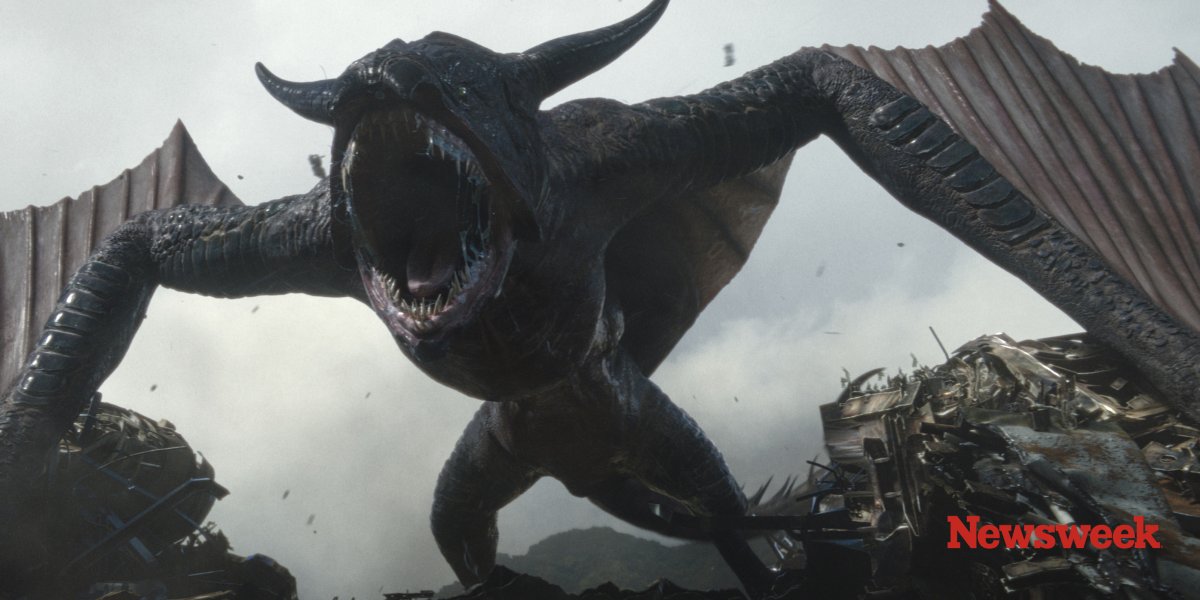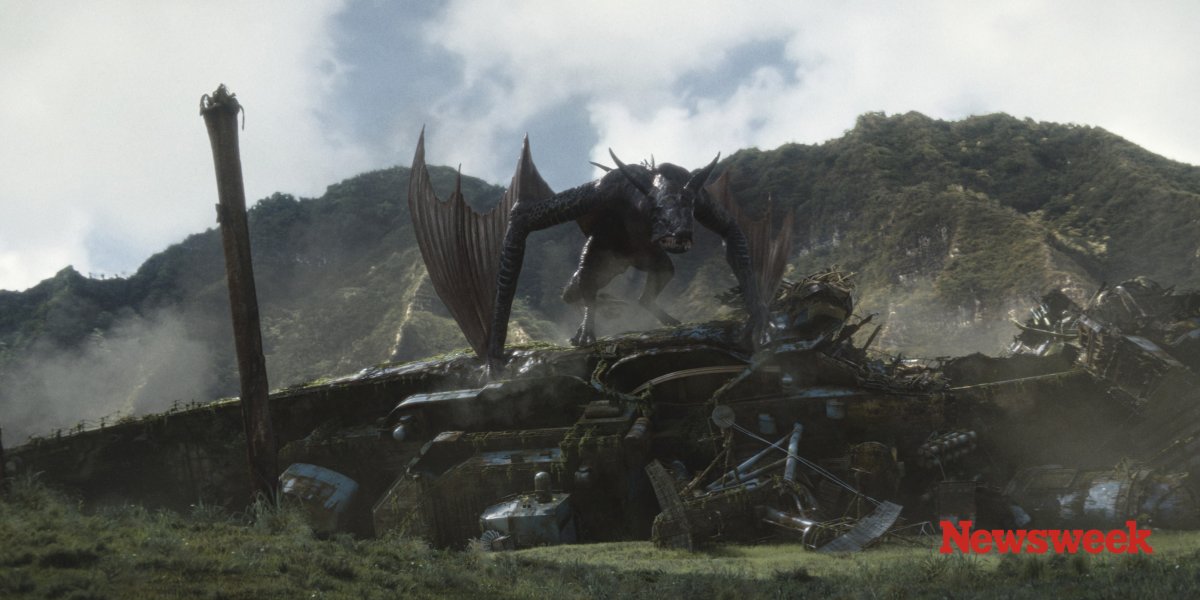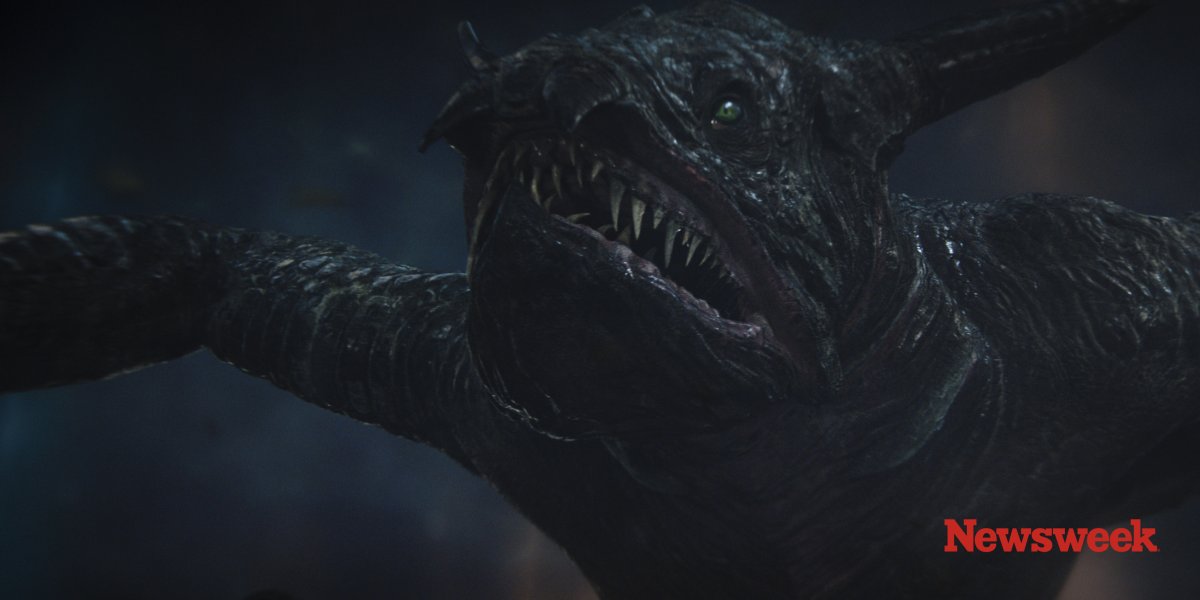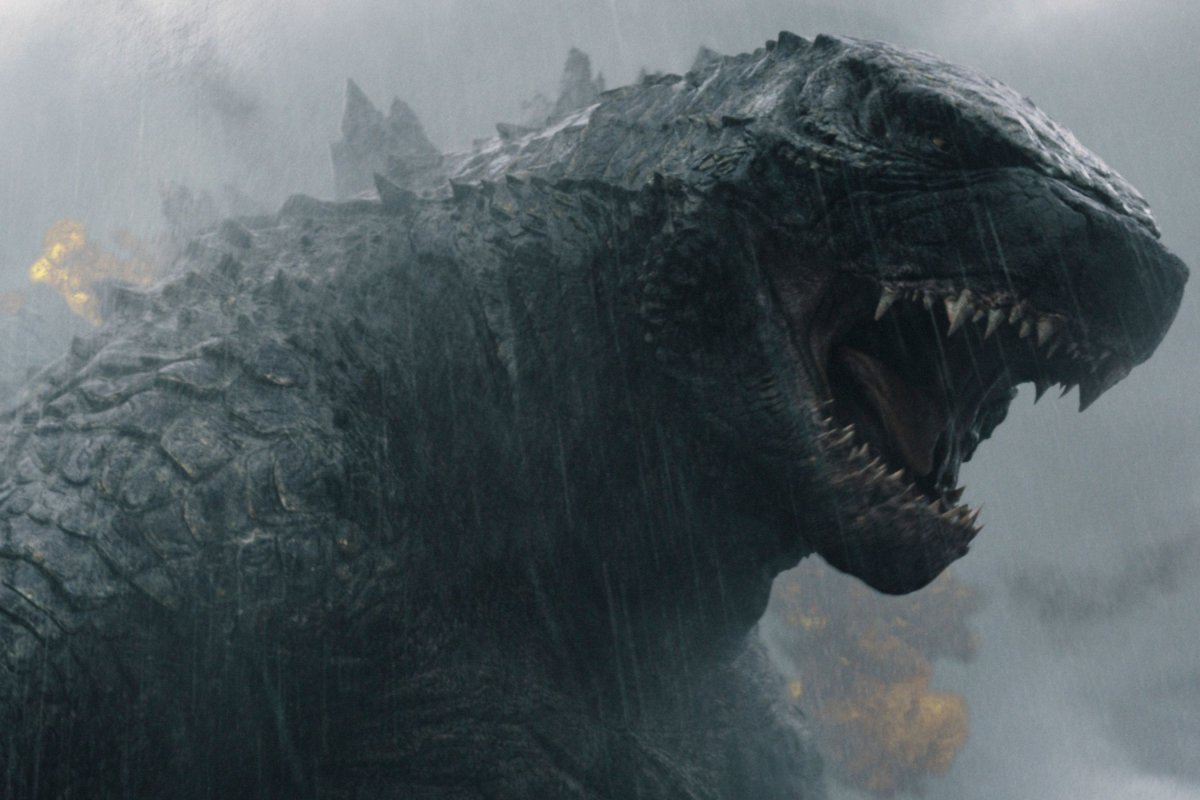Fans of Godzilla and the "MonsterVerse" rejoice—the new Apple TV+ series Monarch: Legacy of Monsters has answered a question that has plagued the fandom since 2017.
For years, viewers have speculated whether it was the legendary Titan Godzilla or a mystery monster that destroyed a Navy ship called the USS Lawton mentioned in the 2017 film Kong: Skull Island, an attack that left Bill Randa (John Goodman) as the only survivor.
Thankfully, Monarch: Legacy of Monsters has provided an answer. In episode 2 of the series, which premiered November 17, it is finally revealed that the creature that attacked the USS Lawton is a brand new Titan called the Ion Dragon, and Newsweek has the exclusive details on the creature.
What Is Monarch?
The first live-action TV series in the MonsterVerse takes place across multiple timelines. Though Bill Randa dies in Kong: Skull Island, we meet a younger version of the character in Legacy of Monsters, played by Anders Holm. This strand of the story is set in the 1950s and explores the early days of the covert organization known as Monarch and its quest to learn more about the Massive Unidentified Terrestrial Organisms (MUTOs) that have begun plaguing the world.

The show's other main timeline is set in the aftermath of 2014's Godzilla, but prior to 2019's Godzilla: King of the Monsters. It follows siblings Cate (Anna Sawai) and Kentaro (Ren Watabe) as they follow in their father's footsteps to discover their family's connection to Monarch.
Monarch: Legacy of Monsters delves further into the origins of the organization. Originally established by President Truman following the attack on the USS Lawton, it was a secret for decades. However, by the time of King of the Monsters, it has become an important global force as the world reckons with the arrival of the Titans.
Clues lead Cate and Kentaro into the world of monsters and eventually down the rabbit hole to Army Officer Lee Shaw (played by father-son duo Kurt Russell and Wyatt Russell as the elder and younger Shaw, respectively). Thankfully, if this series is your first encounter with the MonsterVerse, it doesn't require any existing familiarity with the movies—though it does help.
What Attacked the USS Lawton?
The young version of Bill first encounters the Ion Dragon while stationed on the USS Lawton in 1943, when an unidentified creature attacked the vessel and caused it to sink west of Pearl Harbor. During Legacy of Monsters he runs into it again nine years later when he and his colleagues Keiko Miura (Mari Yamamoto) and Lee (Wyatt Russell) come across the wreckage of the ship in the middle of a jungle in the Philippines.
The MonsterVerse is a shared fictional universe featuring Godzilla, King Kong, and other characters owned and created by entertainment company Toho, with the franchise produced by Legendary Pictures. Legacy of Monsters executive producer/director Matt Shakman and VFX supervisor Sean Konrad collaborated with both companies when bringing this series to life.
Newsweek spoke to Shakman and Konrad via email about what the series has in store for viewers, as well as how it felt finally being able to reveal the Ion Dragon and reveal a key piece of MonsterVerse mythology. This interview has been lightly edited and condensed for clarity, and contains spoilers for episodes one and two of Monarch: Legacy of Monsters.
Newsweek: Theories about what sunk the USS Lawton have been swirling among the fandom for years at this point, how does it feel to be able to solve that key MonsterVerse mystery?
Shakman: I love the way the show plays with existing lore and mythology, answering old questions and posing new ones. So if you are a MonsterVerse fan, there are a ton of Easter eggs and reveals. But what is equally exciting is if you know nothing about the MonsterVerse films, the story works beautifully—giving you everything you need to know to follow the story.
Konrad: There's a lot about how this scene was realized that we're proud of, but part of what I like about this from a storytelling point of view is that we've left ambiguity in the details, and as many things as we answer about the wreck of the ship, the script has created even more questions for fans to chew on. We find a creature inside the hull of the ship, but it's potentially too small to have dragged it to the middle of the jungle by itself, so is this the child of something larger, did it stumble on the ship and use it as a nest, or did it fall through one of the portal networks that we know exist in the canon? Or is there some other possibility that isn't immediately evident? The creature is also completely incongruent with the environment—so why is it here? We still don't know how Billy survived or what happened the night the ship sank as well.
I think this is more successful than just showing literally what happened as a flashback because there's opportunity to expand this story further outside of this episode—in short, the world starts to feel bigger because there are more possibilities.

Can you take us through the development process for the Ion Dragon, both in terms of the visuals and its characteristics and back story?
Shakman: We knew it needed to be dragon-like—this was clear from the dialogue Chris [Black] and Matt [Fraction, the showrunners] had written. Billy says the locals have a legend about a dragon and Lee sees the creature and says, "It really is a dragon." We knew it needed to ooze nacre that encapsulates bodies. And we knew it needed to be big since it took down a large battleship and then carried it from Pearl Harbor to the Philippines. We played with a lot of different inspirations. Starting with birds and then hyenas and ultimately an anglerfish, whose teeth influenced the mouth quite a bit.
Part of the joy of making a new monster is looking at the amazing creatures that are already on this planet, combining them and then making them huge. We went through a lot of versions, playing with the profile, adjusting the wings and the claws, altering color and texture, until we felt the dragon was as terrifying as it needed to be.
Konrad: This was one of the more challenging creatures that we designed because we completely rethought it multiple times. Sometimes in the scripts, we'd have a really clear direction of what the writers wanted out of the creature design, and other times we'd have numerous meetings where we'd go through what the creature needed to do, what the back story might be, and from there we'd figure out what the monster could be. In the first episode, we wanted all of our creatures to feel part of the environments where they were situated on Skull Island. That means their biology is literally based on the terrain, and in the plutonium plant the endoswarm are giant-sized insects that you could imagine crawling around in the dark crevices of a cave.
For the Ion Dragon, we knew that we wanted the creature to fly, so we initially talked about making it into a birdlike creature using fauna from the Philippines as an inspiration, but nothing we did felt sufficiently scary and we couldn't square how this would have related to a World War II destroyer in the middle of the ocean. So we started playing with the idea that maybe this thing should be incongruent with the environment. Presumably, the ship was attacked when it was in the water, and the bottom of the ocean is full of weird/ugly and amazing creatures that are inspiring. The concept team at MPC ended up riffing on the mouth of an angler fish. This turned out to be the critical turning point for the design and it evolved quickly from there.
We wanted to identifiably make this creature a dragon to tie into Billy's line earlier in the episode, but we didn't want to repeat the dragon design that's been used in other media—which meant no neck frills, long necks and bulky bodies. The wings are loosely based on exocoetidae (flying fish). Once we had those pieces in, they went with a slightly more Gargoyle-ish body and gave it a spiked tail. We then turned the rough design over to Weta [a visual effects company] who did a few rough flight cycles—it became apparent that the original design didn't have sufficient wingspan and its legs were too long / not flight ready, so they further tweaked proportions until we felt like we had something that could more plausibly fly.
It was also critical that this thing could have some simple facial expressions—it doesn't need to communicate a ton of emotion other than rage, hunger, and maybe inquisitiveness, but we needed enough features to show that range—conversely our creatures in the first episodes don't really emote so it's a totally different prospect. Fortunately, Weta has a long history of doing this kind of facial animation and figured that out.

Fans have gone back and forth over whether Godzilla was behind the attack on the Lawton for years, so presumably you had to come up with a Titan that could do a similar kind of damage but still be distinct—the reveal was terrifying and there was a real horror movie vibe about those scenes in episode two. Matt, can you talk us through directing those scenes in particular and building up to the big reveal?
Shakman: What you imagine is always more terrifying than what you see. So I leaned into sound at the beginning—was that a creak in the ship or something alive? And I used Billy's Bolex camera POV as a way to build tension. The 16mm camera only allows you to see a sliver of this creepy ship. As Keiko and Billy delve deeper into the Lawton, warning signs mount. First, it's the mysterious nacre. Then the horrifying bodies of Billy's shipmates. But it's not till Keiko and Billy find the fresh nacre that they realize there's something else alive in there with them. When the dragon shows itself, it's in stages. First the impression of a talon. Then the talon itself. Then a full hand. Ultimately we see the ion dragon in all its glory as it emerges from the ship. It's the rule of JAWS—hold back showing the creature for as long as possible so the imagination can go to work, projecting danger into every corner.
The Lawton sequence was complicated to film. It involved sets built in Vancouver by our amazing art department that brought to life an overgrown, wet, rusted period battleship. The final hallway where they encounter the dragon was built on a huge gimble so the set could turn as the ship starts to tilt. And that hallway set also shook like crazy, courtesy of the amazing special effects team. I try to get as much in camera as possible—the more that's real in the frame and the more the actors have real things to react to, the more believable the sequence will be. In addition to the sets in Vancouver, we shot the Lawton exteriors in Hawaii. Billy and Keiko discovering the ship, walking alongside it, and the trio escaping at the end and diving for safety all happened in a gorgeous valley on Oahu that's hosted many films before, starting with the first Jurassic Park. Just like the incredibly detailed sets, being in that gorgeous valley helped bring the dragon to life.
What's the process for creating a new Titan and collaborating with Toho and Legendary to add to the canon? Is it carte blanche, or are there certain rules you have to adhere to?
Konrad: We initially talked about whether we wanted this to be a Toho creature, and looked at a few options but ultimately decided that this early in the season we still needed to be doing something original for the show. Legendary mostly just wanted to make sure we didn't retread things they'd already done or step on what they were planning to do. One example is that we early on had the wings a bit more leathery, like a bat, which felt too similar to the 2014 MUTOs. We were working with concept artists/art directors who were familiar with the MonsterVerse and had worked on prior films and there wasn't a huge creative barrier in making it feel coherent.
Shakman: It's important that we create creatures that fit their environment, so the first question is "Where does this monster live?" The flora and fauna of the creature's environment will impact the design. We research that environment to find the craziest critters that actually exist to inspire us (and that we can combine in interesting ways). And then we scale them up! Toho and Legendary were very encouraging during the process and are excited to add new creatures to the canon.

The joy of a series centered around Monarch is that you have a huge sandbox of Titans old and new to experiment with, how do you go about choosing which iconic monsters to feature and when to create something new?
Konrad: Whenever there's a piece of connective tissue to the films, we want to use those creatures to reinforce that legacy. We used the Mother Longlegs spider in episode one (tweaked slightly for the color of bamboo it runs through and shrunk to make it work with the terrain) because it appeared in a scene from Skull Island that allows us to bring John Goodman's character into the story—the crab has some design elements from another MonsterVerse creature that fans have picked up on. I wanted to do this to depict that these creatures evolve and change depending on the biome they're in and that these creatures move around, just like creatures move around the real world.
For the most part, we wanted to design creatures and our set pieces to make our heroes feel like they're in the action, and sometimes that means we shrink them down to the human level, and other times they're huge but we're only seeing a portion of them. In this case, we get very intimate with the dragon's claw in the hallway scenes and we see the aftermath of its presence earlier in the episode (the destroyed ship and the nacreous bodies in the control room). Designing for the show allowed us to support the narrative with our creature design rather than bolt the narrative onto a set piece based on the creature.
I personally love a lot of Toho creatures and would love to work on them, but if we do it then it needs to make sense for the story we're telling and so far that hasn't been the case. The comics have also done interesting things that we tried to pull from. We did a concept of one creature from an appendix in one of the comics, and it was one of our biggest and most immediate hits with the creative teams, but when we scouted Hawaii we decided it didn't make sense for any of the shooting locations we had available to us and pivoted.
Shakman: What I love about the show that Chris and Matt created is that it is a human drama where the monsters shape and affect our character's lives. We aren't pausing the human drama to see Titans fight. Godzilla plays a huge role in both Lee and Cate's lives. And new Titans were created along the way by Matt and Chris to do the same. In terms of the decision to use an existing monster or design a new one, the general rule was: if there already exists a Titan who fits the environment where our characters find themselves, then we would use that creature from the canon. If there wasn't a creature that fit, we made a new one. Sometimes we did both! The opening of episode one shows John Goodman's Randa running from a bamboo spider we met in Kong: Skull Island, only to encounter a brand new giant crab Titan. This combination of old and new Titans, entering the story to shape our characters, is an exciting part of the fabric of the show.

Where do you draw inspiration from when designing a new Titan?
Konrad: We try to start from something in the natural world as the basis, and then elaborate with science fiction stylization. In the case of the Ion dragon, it's an anglerfish, but you could also see bits of a shark mixed with a gargoyle, with raptor-like claws and a tail with calcified spikes. When we go back to finish the creature in terms of detailing, we go look at those original real-world images and use that as inspiration to make it more real.
Sometimes we'd look at art from creators we liked but often that was a dead end because we found it too repetitive with existing ideas. Ultimately we strive for novelty wherever possible.
Are there any notable visual updates to Godzilla? Since we're skipping through time periods, do you try to show a subtle evolution over the course of the show?
Konrad: We didn't want to update Godzilla's look because he has established looks in the timeline of the films. After the 2014 film, he's been so damaged that his spines regrow differently (kind of like the antlers of a deer) and there's some damage to his tail and other subtle things that change between that film and King of the Monsters. We're not showing that change, we're just picking him up between those changes. But we do see him in both of these forms.
We did add complexity to the 2014 Godzilla asset because we get closer to his spines than we did in the original film in one shot that's in a few trailers. That wasn't changing more than just adding breakup to the existing asset, eventually, we also make him a bit more dirty to tie into the environment he's in in one context.
The scope of the series is every bit as cinematic and expansive as the movies — are there any challenges or differences in approach for the show?
Konrad: For VFX it's a huge challenge because when VFX services eight-plus hours of content versus two-plus hours you end up with a lot more variety of environments, creatures, lighting, etc. which makes it hard to amortize builds and gain efficiencies in the production pipeline. One of the byproducts is that we needed to engage with a large number of companies to avoid bottlenecks—four different VFX companies worked on Godzilla's various forms for the show because we wanted to avoid bottlenecks on certain episodes and leverage talent for things like water simulation or environment destruction.
Occasionally the economy of these scenes meant that we were really trying to design our shots so that they could fit as much storytelling and characterization for the creatures into small amounts of screen time. Basically, every shot counts and story clarity is incredibly important—it is in the features as well, but we were hyper-aware of it here. I rewatched some of our scenes before we cut them down recently, and in a lot of cases, I kind of prefer these more brief/punchy scenes because we get back to the characters more quickly and the action feels consequential.
For the actual execution, a lot of the same creative techniques worked here that worked on the features worked for the show. One example [is] when I was working on Godzilla 2014 at MPC as an artist, my (multiple Oscar-winning) supervisor Guillaume Rocheron (who was later the overall production VFX supervisor for King of the Monsters) used to do something he called the "iPhone test" for our night scenes when things were really dark. We'd shrink a shot down on our monitors and look at whether or not the shot was legible in a small size. If it was we knew we had the basic composition right, and then we'd blow it back up and work on the detail and make it look good one a full-size OLED or a projector. The technique still works.

Anything else we should know about the Ion Dragon?
Konrad: I like this idea that we see this nacreous coating throughout the interior of the ship, and eventually see desiccated bodies entombed in this material. I like the lore implications here for the creature's physiology, maybe this was a nest, maybe this was a resting spot, maybe this was something that facilitated a phase in its physiology, maybe it's storing the bodies to consume at a different time.
Those shots of the hall of the body were a late addition when Matt Shakman rightly noted that what we shot wasn't sufficiently scary and didn't show the scope we'd wanted (or originally scripted and cut down for production time). I ended up using Storm Studios in Oslo for this work, who had just done some similar shots for a friend of mine on The Last of Us. Fuse helped us fill out the hallways with dripping goo and doing a bit of a lift for the production design (which gave us a good basis but we needed something more otherworldly), and then Weta executed all of the actual creature work, which was complicated and involved a ton of difficult simulation work.
More importantly, Billy/Keiko's story has this slow escalation of stakes and we get to experience a Titan from a different point of view than we usually do—that buildup is one of the more unique qualities of the show compared to the features.
Monarch: Legacy of Monsters series kicks off with a two-episode premiere on AppleTV+ on Friday, November 17, before continuing weekly for 10 episodes through the new year.
Uncommon Knowledge
Newsweek is committed to challenging conventional wisdom and finding connections in the search for common ground.
Newsweek is committed to challenging conventional wisdom and finding connections in the search for common ground.
About the writer
Billie is a Newsweek Pop Culture and Entertainment Reporter based in London, U.K. She reports on film and TV, trending ... Read more





